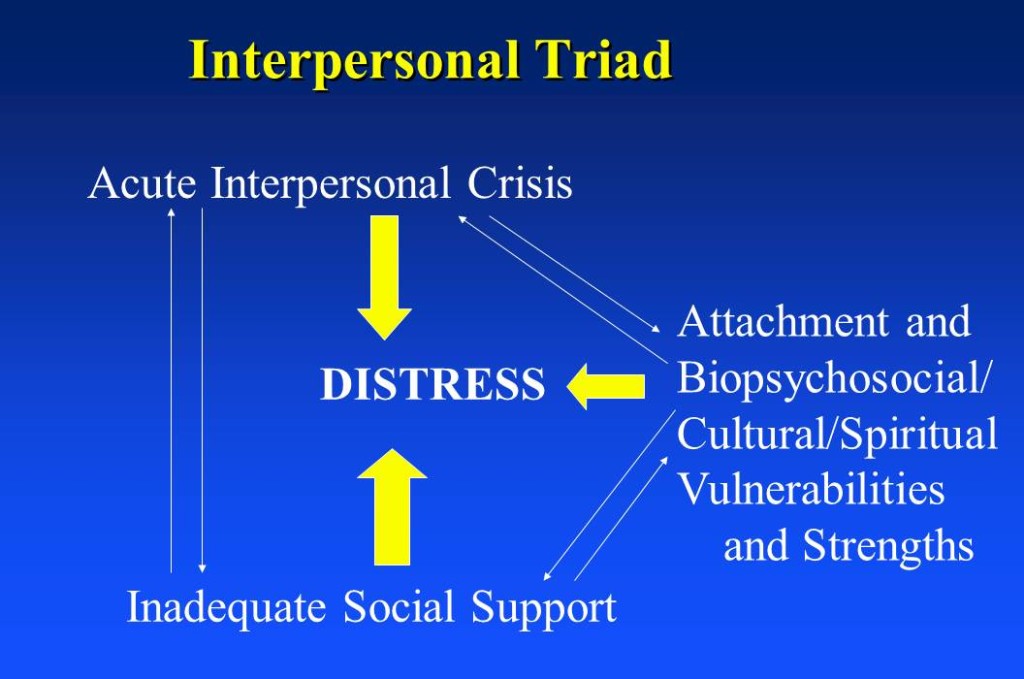About
Interpersonal Psychotherapy
Overview
Interpersonal Psychotherapy (IPT) is an empirically validated treatment for a variety of psychiatric disorders. The evidence for IPT supports its use for a variety of affective disorders, anxiety disorders, and eating disorders, and for a wide range of patients from children and adolescents to the elderly. The evidence base for IPT supports its use from age 9 to 99+.
IPT is recognized as an efficacious psychotherapy by the American Psychiatric Association, the American Psychological Association, and the National Institute for Health and Clinical Excellence in the UK. There are now over 250 empirical studies supporting the efficacy and effectiveness of IPT. Detailed descriptions of IPT can be found in the textbooks listed below.
IPT is a time-limited psychotherapy that focuses on interpersonal issues, which are understood to be a factor in the genesis and maintenance of psychological distress. The targets of IPT are symptom resolution, improved interpersonal functioning, and increased social support. Typical courses of IPT range from 6-20 sessions with provision for maintenance treatment as necessary. The Defining Elements of IPT can best be understood by describing framework for its delivery. This framework can be divided into the theories supporting IPT; the targets of IPT; the tactics of IPT (i.e., the concepts applied in the treatment); and the techniques of IPT (i.e., what the therapist says or does in the treatment). Though individual elements in each of these categories may be shared with other psychotherapeutic approaches, their unique combination defines IPT (Table 1).
Table 1
Defining Elements of IPT
Theory
Attachment Theory, Communication Theory
Targets
Psychiatric Symptoms, Interpersonal Relationships, Social Support
Tactics
- Interpersonal Triad
- Biopsychosocial/Cultural/Spiritual Model
- Interpersonal Inventory
- Interpersonal Problem Areas
- Interpersonal Formulation
- IPT Structure
- Non-Transferential Focus of Interventions
- Present Focus
- Collaboration & Goal Consensus
- Positive Regard for the Patient
Techniques
- Interpersonal Incidents
- Communication Analysis
- Use of Content and Process Affect
- Role Playing
- “Common” Techniques
The Interpersonal Triad
A Model for Psychological Distress
IPT is explicitly based on a Biopsychosocial/Cultural/Spiritual Model. IPT works from the premise that interpersonal distress is connected with psychological symptoms. An acute interpersonal crisis (stressor) begins the process. The ability of the patient to manage the crisis psychologically and biologically is heavily influenced by the patient’s Biopsychosocial/Cultural/Spiritual vulnerabilities (diatheses) and strengths, such as genetic vulnerability to illness, temperament, attachment style, and personality, which may modulate or exacerbate the crisis. Social factors such as a patient’s current significant relationships and general social support provide the context in which the stress-diathesis interaction occurs, and further modify the individual’s ability to cope with his or her distress. Together, these elements form the Interpersonal Triad (Figure 1), which models the basic IPT conceptualization of the development of psychological distress.
Figure 1

Table 1: The Defining Elements of IPT
Theory: Attachment Theory, Communication Theory
Targets: Psychiatric Symptoms, Interpersonal Relationships, Social Support
Tactics:
- Interpersonal Triad
- Biopsychosocial/Cultural/Spiritual Model
- Interpersonal Inventory
- Interpersonal Problem Areas
- Interpersonal Formulation
- IPT Structure
- Non-Transferential Focus of Interventions
- Present Focus
- Collaboration & Goal Consensus
- Positive Regard for the Patient
Techniques:
- Interpersonal Incidents
- Communication Analysis
- Use of Content and Process Affect
- Role Playing
- “Common” Techniques
The Interpersonal Triad: A Model for Psychological Distress
IPT is explicitly based on a Biopsychosocial/Cultural/Spiritual Model. IPT works from the premise that interpersonal distress is connected with psychological symptoms. An acute interpersonal crisis (stressor) begins the process. The ability of the patient to manage the crisis psychologically and biologically is heavily influenced by the patient’s Biopsychosocial/Cultural/Spiritual vulnerabilities (diatheses) and strengths, such as genetic vulnerability to illness, temperament, attachment style, and personality, which may modulate or exacerbate the crisis. Social factors such as a patient’s current significant relationships and general social support provide the context in which the stress-diathesis interaction occurs, and further modify the individual’s ability to cope with his or her distress. Together, these elements form the Interpersonal Triad (Figure 1), which models the basic IPT conceptualization of the development of psychological distress.

